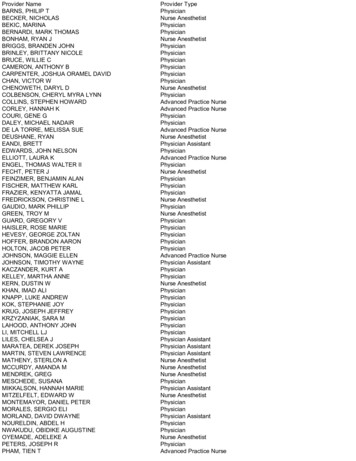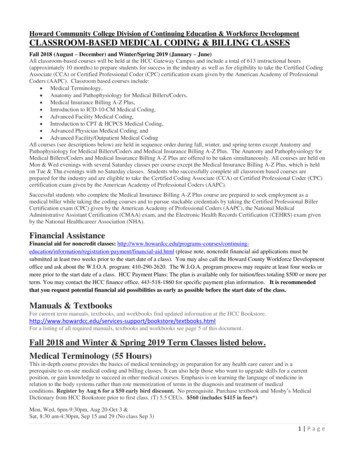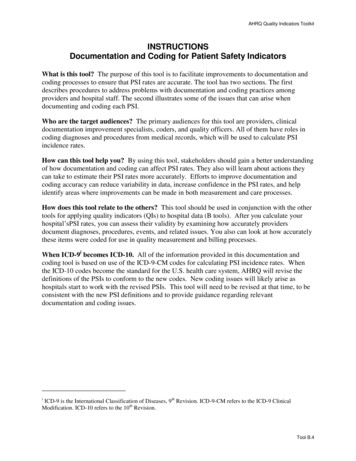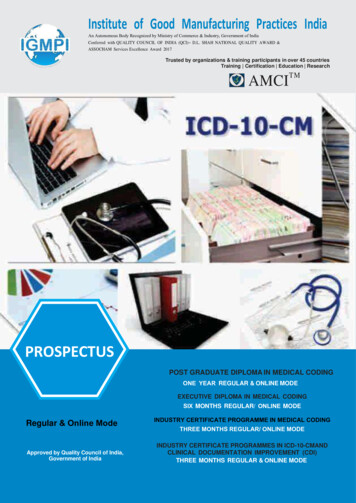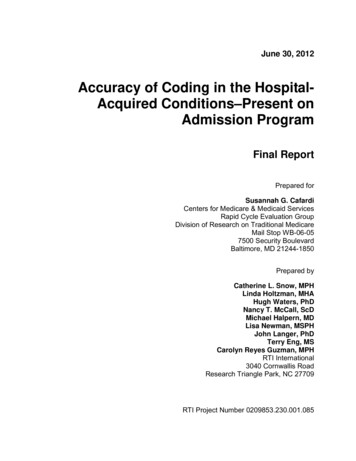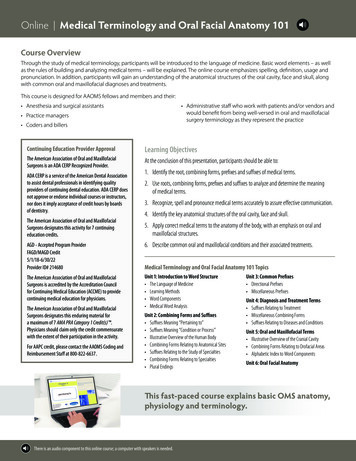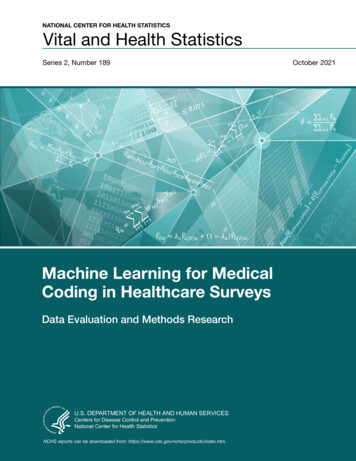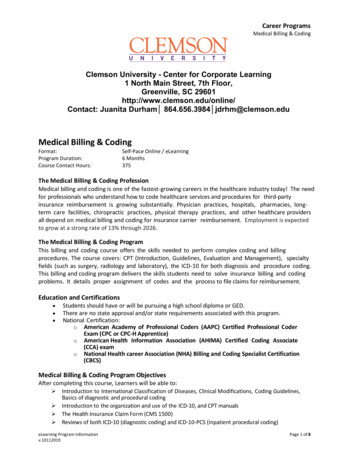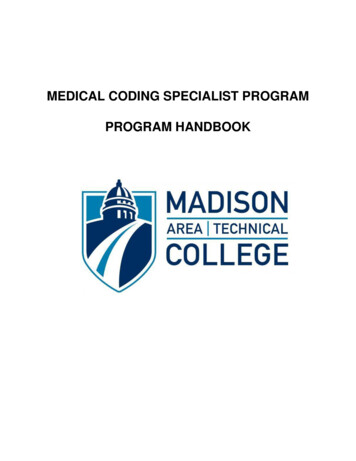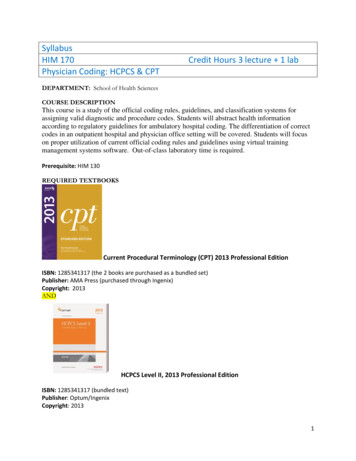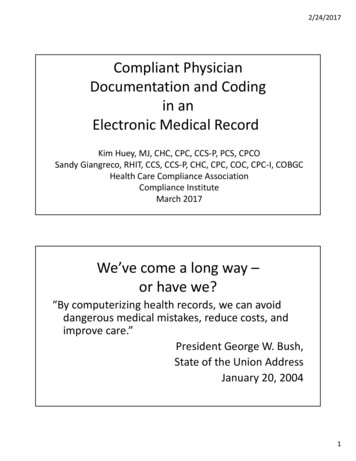
Transcription
2/24/2017Compliant PhysicianDocumentation and Codingin anElectronic Medical RecordKim Huey, MJ, CHC, CPC, CCS‐P, PCS, CPCOSandy Giangreco, RHIT, CCS, CCS‐P, CHC, CPC, COC, CPC‐I, COBGCHealth Care Compliance AssociationCompliance InstituteMarch 2017We’ve come a long way –or have we?“By computerizing health records, we can avoiddangerous medical mistakes, reduce costs, andimprove care.”President George W. Bush,State of the Union AddressJanuary 20, 20041
2/24/2017Issues Is meaningful use really meaningful?Is information available between entities?Is the quality of care improved – or even maintained?Is the health information secure?Are medically necessary services provided,documented, billed for, and reimbursedappropriately?Balancing Medical Necessityand Meaningful Use Bringing forward medical history in an EMR is animportant aspect of meaningful use Does this mean that you can count thatcomprehensive history toward the level of servicefor every encounter now and forevermore? What about medical necessity of elements? Forexample, vitals on every patient?2
2/24/2017Physician ResponseWhat do physicians dislike most about theirEMR? 28.1% interferes with Face to Face/patienttime 21.9% lack of clinical interoperability 18.8% slows down productivityPhysician ResponseStudy: What Do Physicians Read (and Ignore) in Electronic ProgressNotes? Most attention given to Impression and Plan Very little attention given to vital signs, medication lists, andlaboratory results“Optimizing the design of electronic notes may include rethinking theamount and format of imported patient data as this data appears tolargely be ignored.”Applied Clinical special/manuscript/21088/show.html3
2/24/2017Concerns with electronic recordsand overcodingThe Center for Public Integrity –September 2012“coding levels may be accelerating in part because ofincreased use of electronic health records .”“easy to create detailed patient files with just a few clicks”“longer and more complex visits are easier to document”It’s a New WorldPaper Records: Not documented, not done.Electronic Records: You documented it,but did you really do it?4
2/24/2017Sebelius‐Holder LetterSeptember 24, 2012“False documentation of patient care is not justbad patient care; it’s illegal. The indicationsinclude potential ‘cloning’ of records in orderto inflate what providers get /25/business/25medicare‐doc.htmlCongressional ResponseOctober 4, 2012 letter to HHS Secretary Sebelius“ your EHR incentive program appears to be doing more harmthan good.”Request – Suspension of EHR bonus payments and delay penalties forproviders who don’t use EHR Increase what’s expected of meaningful users Block business practices that prevent exchange of information5
2/24/2017OIG Workplan for 2012“We will assess the extent to which CMS made potentiallyinappropriate payments for E/M services and the consistency ofE/M medical review determinations. We will also review multipleE/M services for the same providers and beneficiaries to identifyelectronic health records (EHR) documentation practicesassociated with potentially improper payments. Medicarecontractors have noted an increased frequency of medical recordswith identical documentation across services. Medicare requiresproviders to select the code for the service based upon thecontent of the service and have documentation to support thelevel of service reported.”Previous OIG Reports 2011 – measured EHR use – 2012 – measured EHR use and specified whichsystemNeither study analyzed effectiveness or impacton coding6
2/24/2017OIG 2016 Compendium ofUnimplemented RecommendationsONC and CMS should collaborate to develop acomprehensive plan to address fraudvulnerabilities in electronic health records(EHR).7
2/24/2017What are the auditors looking for? Authentication – signatures, dates/times – whodid what? (metadata?) Contradictions – between HPI and ROS, examelements and impression and plan Wording or grammatical errors/anomalies Medically implausible documentationCode Generators Is the coding software programmed for the 1995 or 1997Documentation Guidelines? Has the coding software been programmed to account formedical policies specific to the local Medicare contractor? How does the coding software manage dictated portions ofthe encounter such as History of Present Illness?How does the coding software distinguish between thelevels of medical decision‐making?MORE on this later!8
2/24/2017Templates Is the provider able to choose only part of atemplate or to personalize a template? Are there multiple templates, personalized forcomplaint or diagnosis? Are the various contributors to the encounteridentified? Nursing staff, physician, etc.Cloned Notes“Documentation is considered cloned when each entry in themedical record for a beneficiary is worded exactly like orsimilar to the previous entries. Cloning also occurs whenmedical documentation is exactly the same frombeneficiary to beneficiary. It would not be expected thatevery patient had the exact same problem, symptoms, andrequired the exact same treatment.First Coast Service Options, Medicare Part B newsletter 2006(Definitions published by Medicare contractors as early as 1999.)9
2/24/2017Cloned NotesNovember/December 1999 Medicare Bulletin:“Cloned notes are notes that have little or nochange from day to day and patient to patient.These types of notes do not support the medicalnecessity of a visit. More importantly, in somecases, they may not actually support that a visitoccurred. Cloned notes may be construed as anattempt to defraud the Medicare program.”Cloned DocumentationWhether the documentation was the result of an ElectronicHealth Record, or the use of a pre‐printed template, orhandwritten documentation, cloned documentation will beconsidered misrepresentation of the medical necessityrequirement for coverage of services due to the lack ofspecific individual information for each unique patient.Identification of this type of documentation will lead todenial of services for lack of medical necessity and therecoupment of all overpayments made.– NGS Medicare ‐10
2/24/2017Copy and PasteAHIMA Position Statement – March 17, 2014Called on industry stakeholders, EHR systemdevelopers, the public sector, and healthcareproviders to work together to implementstandards for the appropriate use of copy andpasteWhy copy and paste?“ most physicians use the functionality simply to savetime. They have not been given the time andtraining needed to become fully proficient with theirnew systems, so they create workarounds to helpthem get through their day.”Heather Haugen, PhD“Overcoming the Risks of Copy and Paste in EHRs”Journal of AHIMA, June 201411
2/24/2017June 2014 – JAMA Internal Medicine – University of WisconsinSchool of Medicine and Public Health and the University ofWisconsin Hospital and Clinics: “it is too easy, and often mistaken, to equate a physician’sroutine use of copy‐and‐paste with fraud. Data replicationis a feature of electronic health records; facts beyond themere use of duplicated text are required to establish that anote may be fraudulent.” It can be efficient and clinically useful when used properly,and that EHRs are “not to blame for the carelessness ofindividual physicians.”Issues with Copy and Paste Outdated or redundant information Inability to identify the author or date of origin ofinformation Unnecessarily lengthy notes Appearance of fraudulent activity – e.g., billing twicefor the same “work” Quality of care and medico‐legal integrity arecompromised12
2/24/2017Coding GuidelinesWritten in general – not specifically forelectronic records Must adapt electronic documentation toexisting guidelinesGeneral Principlesof Medical Record Documentation1. The medical record should be complete and legible.2. The documentation for each patient encounter shouldinclude:––––Reason for the encounter and relevant history, physicalexamination findings and prior diagnostic test resultsAssessment, clinical impression or diagnosisPlan for careLegible identity of the observerFrom CMS Evaluation and Management Documentation Guidelines –stated to be applicable to all types of medical and surgical services in all settings.13
2/24/20173. If not documented, the rationale for ordering diagnosticand other ancillary services should be easily inferred.4. Past and present diagnoses should be accessible to thetreating and/or consulting physician.5. Appropriate health risk factors should be identified.6. The patient’s progress, response to and changes intreatment, and revision of diagnosis should bedocumented.7. The CPT and ICD codes reported on the health insuranceclaim form or billing statement should be supported bythe documentation in the medical record.Evaluation and ManagementDocumentation GuidelinesTwo sets of guidelines established by CMS– 1995 Documentation Guidelines– 1997 Documentation GuidelinesProviders may use whichever they choose.Auditors are instructed to audit under both sets of guidelinesand allow the physician to use whichever benefits him/her.Are there separate CPT Documentation Guidelines?14
2/24/2017Evaluation and Management History Examination Medical Decision‐MakingHistory DG: The CC, ROS and PFSH may be listed as separate elements ofhistory or they may be included in the description of the history ofthe present illness. DG: A ROS and/or a PFSH obtained during an earlier encounterdoes not need to be re‐recorded if there is evidence that thephysician reviewed and updated the previous information. Thismay occur when a physician updates his or her own record or in aninstitutional setting or group practice where many physicians usea common record. The review and update may be documentedby:– describing any new ROS and/or PFSH information or noting there hasbeen no change in the information; and– noting the date and location of the earlier ROS and/or PFSH.15
2/24/2017History DG: The ROS and/or PFSH may be recorded byancillary staff or on a form completed by the patient.To document that the physician reviewed theinformation, there must be a notation supplementingor confirming the information recorded by others. DG: If the physician is unable to obtain a history fromthe patient or other source, the record shoulddescribe the patient's condition or other circumstancewhich precludes obtaining a history.History DG: The medical record should clearly reflect the chief complaint.The HPI is a chronological description of the development of the patient'spresent illness from the first sign and/or symptom or from the previousencounter to the present. It includes the following elements: location, quality, severity, duration, timing, context, modifying factors, and associated signs and symptoms.16
2/24/2017History of Present IllnessExtended History of Present Illness DG: The medical record should describe atleast four elements of the present illness(HPI), or the status of at least three chronic orinactive conditions. (1997 Guidelines)History of Present IllnessWho must document the History of Present Illness?DG: The ROS and/or PFSH may be recorded byancillary staff or on a form completed by thepatient. To document that the physicianreviewed the information, there must be anotation supplementing or confirming theinformation recorded by others.17
2/24/2017History – Review of Systems DG: At least ten organ systems must bereviewed. Those systems with positive orpertinent negative responses must beindividually documented. For the remainingsystems, a notation indicating all other systemsare negative is permissible. In the absence ofsuch a notation, at least ten systems must beindividually documented.History – Past, Family, Social DG: At least one specific item from two of the three history areasmust be documented for a complete PFSH for the followingcategories of E/M services: office or other outpatient services,established patient; emergency department; domiciliary care,established patient; and home care, established patient. DG: At least one specific item from each of the three history areasmust be documented for a complete PFSH for the followingcategories of E/M services: office or other outpatient services,new patient; hospital observation services; hospital inpatientservices, initial care; consultations; comprehensive nursing facilityassessments; domiciliary care, new patient; and home care, newpatient.18
2/24/2017Examination1995 – Organ Systems/Body Areas1997 – Specific bullet points in each OrganSystemMany EMR templates based on 1997 bullets, butare all those elements really performed?Is the exam related to the presenting problem?One click to document a completely, normalcomprehensive examination?Medical Decision‐Making DG: For each encounter, an assessment, clinicalimpression, or diagnosis should be documented. It may beexplicitly stated or implied in documented decisionsregarding management plans and/or further evaluation.– For a presenting problem with an established diagnosis therecord should reflect whether the problem is: a) improved, wellcontrolled, resolving or resolved; or, b) inadequately controlled,worsening, or failing to change as expected.– For a presenting problem without an established diagnosis, theassessment or clinical impression may be stated in the form ofdifferential diagnoses or as a "possible", "probable", or "ruleout“ (R/O) diagnosis.19
2/24/2017Medical Decision‐Making DG: The initiation of, or changes in, treatment shouldbe documented. Treatment includes a wide range ofmanagement options including patient instructions,nursing instructions, therapies, and medications. DG: If referrals are made, consultations requested oradvice sought, the record should indicate to whom orwhere the referral or consultation is made or fromwhom the advice is requested.Medical Decision‐Making DG: If a diagnostic service (test or procedure) is ordered, planned,scheduled, or performed at the time of the E/M encounter, the typeof service, eg, lab or x‐ray, should be documented. DG: The review of lab, radiology and/or other diagnostic testsshould be documented. A simple notation such as "WBC elevated"or "chest x‐ray unremarkable" is acceptable. Alternatively, thereview may be documented by initialing and dating the reportcontaining the test results.NOTE: This is not acceptable documentation for billing for theprofessional interpretation of X‐rays or other diagnostic services.20
2/24/2017Medical Decision‐Making DG: A decision to obtain old records or decision to obtainadditional history from the family, caretaker or other source tosupplement that obtained from the patient should be documented. DG: Relevant findings from the review of old records, and/or thereceipt of additional history from the family, caretaker or othersource to supplement that obtained from the patient should bedocumented. If there is no relevant information beyond thatalready obtained, that fact should be documented. A notation of“Old records reviewed” or “additional history obtained from family”without elaboration is insufficient.Medical Decision‐Making: Risk DG: Comorbidities/underlying diseases or other factors thatincrease the complexity of medical decision making by increasingthe risk of complications, morbidity, and/or mortality should bedocumented. DG: If a surgical or invasive diagnostic procedure is ordered,planned or scheduled at the time of the E/M encounter, the type ofprocedure, eg, laparoscopy, should be documented. DG: If a surgical or invasive diagnostic procedure is performed atthe time of the E/M encounter, the specific procedure should bedocumented. DG: The referral for or decision to perform a surgical or invasivediagnostic procedure on an urgent basis should be documented orimplied.21
2/24/2017Time‐Based Coding DG: If the physician elects to report the levelof service based on counseling and/orcoordination of care, the total length of timeof the encounter (face‐to‐face or floor time, asappropriate) should be documented and therecord should describe the counseling and/oractivities to coordinate care.Time – Counseling and Coordination of CareMedicare Claims Processing Manual –Chapter 12, Section 30.6 The code selection is based on the total time of the face‐to‐face encounter or floor time, not just the counseling time.The medical record must be documented in sufficient detailto justify the selection of the specific code if time is thebasis for selection of the code. The duration of counseling or coordination of care that isprovided face‐to‐face or on the floor may be estimated butthat estimate, along with the total duration of the visit,must be recorded when time is used for the selection ofthe level of a service that involves predominantlycoordination of care or counseling.22
2/24/2017Surgical ProceduresThe Joint Commission and other accreditingagencies address standards for surgerydocumentation in hospital setting Who sets standards for in‐office procedures?ProceduresOffice Procedures Sometimes documented as orders or CPTdescription without details of the procedureperformedEX: “20610 ‐ Arthrocentesis, aspiration and/orinjection, major joint or bursa (eg, shoulder, hip,knee, subacromial bursa); without ultrasoundguidance”23
2/24/2017Procedure DocumentationProcedure:We reviewed the procedure of joint aspiration and injection and discussed therisks, benefits, and alternative treatments. Informed consent was obtained asoutlined below. I verified that the patient had no allergies to local anesthetic. Wediscussed the potential side effects of corticosteroids, including but not limited tolocal tissue breakdown, elevation of blood sugar and seizures.A procedural pause was conducted to verify correct patient identity, procedure tobe performed, correct side and site, correct patient position, availability ofimplants, and need for special equipment or special requirements. Afterverification, the was marked and then prepped in the usual sterile fashion. Using a22 gauge 1.5 inch needle, 4 mL of lidocaine and was injected into the joint spacewithout difficulty. After injection, the joint was passively moved through the fullrange of motion and a sterile dressing was applied. The patient tolerated theprocedure well. Aftercare discussed.Office DocumentationAt a minimum: Document medical necessity Document specifics of procedure –––––Site and length of lacerationMargins for lesion removalReason for lesion removalTechnique of procedure Details needed to support the code billed24
2/24/2017Diagnosis Coding Have the physicians been educated in diagnosiscoding? Has the diagnosis code listing been personalizedfor that practice and that physician?As more physician payment mechanisms are basedon severity of illness, correct and specificdiagnosis coding becomes more important – tothe physician.Examples of Diagnosis Coding Errors Incorrect/incomplete description entered in EMR– “intestinal obstruction”K50.012 ‐ Crohn's disease of small intestine withintestinal obstruction– “chronic insomnia”F51.04 ‐ Psychophysiologic insomnia Lack of physician knowledge of coding guidelines25
2/24/2017Code #s in Lieu of DiagnosisProviders must specifically document the diagnosis,condition, and/or problem. It is not appropriatefor providers to list the code # or select a code #from a list of codes in place of a writtendiagnosis.Coding Clinic 4Q 2015Diagnosis Documentation How the provider documents the diagnosismatters This information may be presented to patient onVisit SummaryDoes the diagnosis code description in the EMRreflect what the patient was told about theircondition?26
2/24/2017ScribesNo CMS policy on scribes ‐ Noridian: If the physician uses a scribe (an individual taking notes), thescribe needs to fully sign the note, with their own credentials, followed bythe physician's signature and credentials. WPS: "Scribe" situations are those in which the physician utilizes theservices of his, or her, staff to document work performed by thatphysician, in either an office or a facility setting. In Evaluation andManagement (E/M) services, surgical, and other such encounters, the"scribe" does not act independently, but simply documents the physician'sdictation and/or activities during the visit. The physician who receives thepayment for the services is expected to be the person delivering theservices and creating the record, which is simply "scribed" by anotherperson.Beware of “Make Me The Author” functionsCIGNA on ScribesIf a nurse or mid‐level provider (PA, NP, CNS) acts as a scribe for thephysician, the individual writing the note (or history or dischargesummary, or any entry in the record) should note "written byxxxx, acting as scribe for Dr. yyy." Then, Dr. yyyy should co‐sign,indicating that the note accurately reflects work and decisionsmade by him/her. Note: The scribe is functioning as a “livingrecorder,” recording in real time the actions and words of thephysician as they are done. If this is done in any other way, it isinappropriate. This should be clearly documented as noted, byboth the scribe and the physician. Failure to comply with theseinstructions may result in denial of claims.27
2/24/2017Advanced Practice Providers:Incident‐toIn order to bill services incident‐to a physician(Medicare requirements): Employee of the physician Following a plan of care established by thephysician Physician is in the office suite and immediatelyavailableHow do you support this in the EMR?Advanced Practice Providers:Split/Shared“When a hospital inpatient/hospital outpatient or emergencydepartment E/M is shared between a physician and an NPP fromthe same group practice and the physician provides any face‐to‐faceportion of the E/M encounter with the patient, the service may bebilled under either the physician’s or the NPP’s UPIN/PIN number.However, if there was no face‐to‐face encounter between thepatient and the physician (e.g., even if the physician participated inthe service by only reviewing the patient’s medical record) then theservice may only be billed under the NPP’s UPIN/PIN.28
2/24/2017Advanced Practice Providers:Split/SharedCompliant Documentation Identify which portions of the visit have beenperformed by the physician “Seen and agree” means no fee! Hospital dictation system may not allow APPsto document independentlyCare Management Services Transitional Care Management – code is for 30 days of care, not justF2F visit– Phone call documented?– Overall management of patient’s needs, including psychosocial needs Care Plan Oversight Chronic Care Management– Time spent – every patient always requires 20 minutes– Generic care plan – not specific to patient’s condition/needs Advance Care Planning– Every patient documented with just the minimum time to support thecode29
2/24/2017HospitalIssues – Unable to determine reason for visit Visit documentation incomplete – nohistory/examination/diagnosis Run‐on visits – documentation continuousfrom one day to the nextAddendaAre addenda done for the proper reasons and documentedappropriately?Medicare Program Integrity Manual, Chapter 3 – Section 3.3.2.5.B“Regardless of whether a documentation submission originates from apaper record or an electronic health record, documents submittedto MACs, CERT, Recovery Auditors, and ZPICs containingamendments, corrections or addenda must:1. Clearly and permanently identify any amendment, correction ordelayed entry as such, and2. Clearly indicate the date and author of any amendment, correctionor delayed entry, and3. Clearly identify all original content, without deletion. “30
2/24/2017SignaturesMedicare Program Integrity Manual, Chapter 3 – Section 3.3.2.4.E“Providers using electronic systems need to recognize that there is apotential for misuse or abuse with alternate signature methods. Forexample, providers need a system and software products that areprotected against modification, etc., and should apply adequateadministrative procedures that correspond to recognized standardsand laws. The individual whose name is on the alternate signaturemethod and the provider bear the responsibility for the authenticity ofthe information for which an attestation has been provided. Physiciansare encouraged to check with their attorneys and malpractice insurersconcerning the use of alternative signature methods. “Finalizing the DocumentationCode Selection Is the physician able to override the code selected bythe EHR? Can he/she override the code to a higher level or onlyto a lower level of service?Signatures Is the provider able to sign off on multiple items withone “sign‐off” – multiple encounters, test results,phone calls, prescriptions31
2/24/2017“Charge Passing”Codes chosen in EMR transmit directly toPractice Management system and are thenbilledTiming of Billing Is the documentation complete before theencounter is billed? For ancillary services, is the bill “dropped”based when the order is entered or when thetest is performed and results entered?32
2/24/2017Resources cation/electronic‐health‐records.html Appropriate Use of the Copy and Pastefunctionality in Electronic Health Recordshttp://bok.ahima.org/PdfView?oid 300306 Electronic Health Record Compliance Framework,Health Care Compliance Professional’s ManualKim Huey, MJ, CHC, CPC, CCS‐P, PCS, mSandy Giangreco, RHIT, CCS, CCS‐P, CHC, CPC, COC, m orsandy.giangreco@chanllc.com33
claim form or billing statement should be supported by the documentation in the medical record. Evaluation and Management Documentation Guidelines Two sets of guidelines established by CMS - 1995 Documentation Guidelines - 1997 Documentation Guidelines Providers may use whichever they choose.

